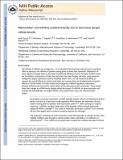| dc.contributor.author | Guo, Huili | |
| dc.contributor.author | Ingolia, Nicholas T. | |
| dc.contributor.author | Weissman, Jonathan S. | |
| dc.contributor.author | Bartel, David | |
| dc.date.accessioned | 2012-08-29T20:43:55Z | |
| dc.date.available | 2012-08-29T20:43:55Z | |
| dc.date.issued | 2010-06 | |
| dc.date.submitted | 2010-02 | |
| dc.identifier.issn | 0028-0836 | |
| dc.identifier.issn | 1476-4687 | |
| dc.identifier.uri | http://hdl.handle.net/1721.1/72447 | |
| dc.description.abstract | MicroRNAs (miRNAs) are endogenous ~22-nucleotide RNAs that mediate important gene-regulatory events by pairing to the mRNAs of protein-coding genes to direct their repression. Repression of these regulatory targets leads to decreased translational efficiency and/or decreased mRNA levels, but the relative contributions of these two outcomes have been largely unknown, particularly for endogenous targets expressed at low-to-moderate levels. Here, we use ribosome profiling to measure the overall effects on protein production and compare these to simultaneously measured effects on mRNA levels. For both ectopic and endogenous miRNA regulatory interactions, lowered mRNA levels account for most (≥84%) of the decreased protein production. These results show that changes in mRNA levels closely reflect the impact of miRNAs on gene expression and indicate that destabilization of target mRNAs is the predominant reason for reduced protein output. | en_US |
| dc.description.sponsorship | National Institutes of Health (U.S.) | en_US |
| dc.language.iso | en_US | |
| dc.publisher | Nature Publishing Group | en_US |
| dc.relation.isversionof | http://dx.doi.org/10.1038/nature09267 | en_US |
| dc.rights | Creative Commons Attribution-Noncommercial-Share Alike 3.0 | en_US |
| dc.rights.uri | http://creativecommons.org/licenses/by-nc-sa/3.0/ | en_US |
| dc.source | PMC | en_US |
| dc.title | Mammalian microRNAs predominantly act to decrease target mRNA levels | en_US |
| dc.type | Article | en_US |
| dc.identifier.citation | Guo, Huili et al. “Mammalian microRNAs Predominantly Act to Decrease Target mRNA Levels.” Nature 466.7308 (2010): 835–840. | en_US |
| dc.contributor.department | move to dc.description.sponsorship | en_US |
| dc.contributor.department | Massachusetts Institute of Technology. Department of Biology | en_US |
| dc.contributor.approver | Bartel, David | |
| dc.contributor.mitauthor | Guo, Huili | |
| dc.contributor.mitauthor | Bartel, David | |
| dc.relation.journal | Nature | en_US |
| dc.eprint.version | Author's final manuscript | en_US |
| dc.type.uri | http://purl.org/eprint/type/JournalArticle | en_US |
| eprint.status | http://purl.org/eprint/status/PeerReviewed | en_US |
| dspace.orderedauthors | Guo, Huili; Ingolia, Nicholas T.; Weissman, Jonathan S.; Bartel, David P. | en |
| dc.identifier.orcid | https://orcid.org/0000-0002-3872-2856 | |
| mit.license | OPEN_ACCESS_POLICY | en_US |
| mit.metadata.status | Complete | |
